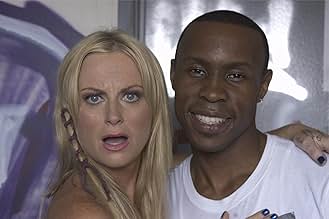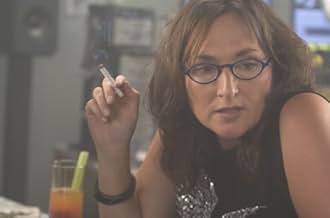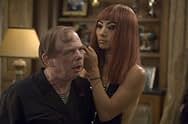Au cours d'une canicule de trois jours juste avant la grande fête du 4 juillet, une star amnésique rencontre une star du porno qui développe son propre projet de télé-réalité, et un policier... Tout lireAu cours d'une canicule de trois jours juste avant la grande fête du 4 juillet, une star amnésique rencontre une star du porno qui développe son propre projet de télé-réalité, et un policier qui détient la clé d'un vaste complot.Au cours d'une canicule de trois jours juste avant la grande fête du 4 juillet, une star amnésique rencontre une star du porno qui développe son propre projet de télé-réalité, et un policier qui détient la clé d'un vaste complot.
- Réalisation
- Scénario
- Casting principal
- Récompenses
- 1 victoire et 3 nominations au total
- UPU 4 Officer 3
- (as Chris Ciulla)
Avis à la une
If you are an average viewer, you will be put off by the apparent narrative incoherence, the seeming lack of center and the childish nature of some of the devices. That's all fair enough. But let me point you to two things that make it for me.
The first is that it is inherently cinematic. It makes about as much sense when the sound is turned off. Indeed I watched the whole thing through this way once and it actually makes more sense. There's lots of cinematic nesting: movies about movies; videos, narratives and disguises within. There's lots of causality denoted visually. You will find scores of quotes from other films, many more than those "parody" teen movies. And you'll discover many of your favorite intelligent but not famous actors.
That would be enough for me, but there's something else. In fact, though the story is confusing, deliberately made so through how it unfolds, it does make complete sense. It makes as much sense as, say, "The Matrix." I wish it didn't, but there you are. But its the way the story slips about that is pretty wonderful. You see, a narrative works by the way the pieces connect.
Usually we don't have to work because the way the pieces connect is the way they happen in real life: the causal flow of the narrative telling is the same as in the story. But the detective story, and modern noir changed that and now we have a variety of causal connections that can glue the bits together. Even these you don't normally notice unless the writer as here makes the shifts between bits cover a greater distance than usual.
Pay attention to this. Greenaway uses reference to number sequence. Barney uses progress through the sexual encounter, clever that. Lynch provides these discontinuities by having characters shift selves a technique of discovery. Joyce who in a way is the gold standard because he reified this sort of art through cognitive plumbing connection depends on notational congruence. All these are exciting as getout in the hands of their masters.
But this is different, more rooted in noir, in cinema. These elements are connected in ways that only read in film.
Here's what I mean: film has evolved a set of notions we call noir. These capture two worlds; the world of the story where the laws of the universe seem to be deliberately arranged by strange occurrences, "mistakes" and coincidences to play havoc with key characters. Then there is the (usually implied) second world where those laws are manipulated and we the viewers sit. In almost all noir films, this effect only occurs in the long form, meaning that it is apparent when seem over the whole story.
Now look here. For all intents, there is no long form here, just a sequence of medium- sized events, each of which contain rather than follow the previous ones. This form was pioneered (I believe) by Altman. The narrative glue of the whole is how the segments slip against one another. We have "Magnolia" that plays with this concept as well, this slipperage. Its the connection that conveys the world. Its subtle and homeopathically powerful as a result.
Now this. Its another step forward in that the connection between elements involves changes in the way the world works. Each shift is not just between story segments that don't make sense, they don't make sense BECAUSE of the nature of the transitions. Many of these transitions involve a change in the laws of the universe. Its as if you were playing chess as a chesspiece, and the rules of the game changed according to the patterns of the pieces on the board. The whole thing would make sense afterward when seem as a whole, but the chessmen will be baffled.
What this does is build an ordinary noir with the two worlds: story, and gods. But it cleverly puts the viewer on the chessboard as someone at the mercy of the rules. Its no accident that the inspiration is Philip K Dick (who invented this sort of reverse introspection), that the key magical plot device is the magically named "fluid karma," and that the mascot is Bai Ling, who was our Béatrice Dalle surrogate for a while.
I want to give this a four, but I do think that the two others from this year are more important.
Ted's Evaluation -- 3 of 3: Worth watching.
The primary thing that keeps the film from succeeding as a whole is its constant shifts in tone. While the filmmakers might argue that they are aping/satirizing the way we get information through the media, it makes for a rotten experience at the cinema. Some scenes are sketch comedy, some are ponderous (in a good sense), there is a bit of action and bit of fun with setting of the film. Without a truly riveting lead character or other weighted focus point it falls apart -- really by the conclusion of the film it's just white noise.
The casting is meant to be part of the media critique, but it's works against the film to keep thinking, 'hey -- that's the guy from Revenge of the Nerds and Moonlighting again', and keeps you distracted from the plot and characters' relationship to the plot. When thinking of this aspect of the film AFTER viewing it's a straightforward idea -- hey the filmmakers are saying that the government is using entertainment to keep us from following the real news, man! But during the actual experience of watching the film, the casting starts one thinking of Mars Attacks or dare I say it, Cannonball Run......
The lighting was very flat, which I assume again is part of the 'fast food media' critique - but ugly is still ugly. Especially considering Donnie Darko I was expecting something worth looking at visually. There are some big IDEAS presented visually, but they are not visually interesting in a formal sense. There has to be SOMETHING for the audience to hang its hat on beyond an idea. Cinema is a sensate experience, not merely an intellectual one.
I look forward to reading about this someday in Scott Tobias's "My Year Of Flops - Redux" on the Onion AV Club....
The year is 2008. Justin Timberlake - did I forget to mention him? He plays a drugged-up Iraq war veteran with a huge scar on his face. Who sits in a huge chair with a huge rifle, guarding "Fluid Karma", an ultra-valuable perpetual motion wave machine that is the new form of power since oil has become rare and therefore massively expensive. Politics, anyone? Anyway, JT (who might be telepathic) narrates over an introduction comprised of graphic novel slides and MTV-meets-FOX news bulletins that guides us from our present to the "present" of Kelly's 2008 Southland. The passage of time has not been kind to the US; a nuke has gone off in Texas, and the country has become a police state. The most "recent" clip reveals that Boxer (played by Dwayne Johnson playing The Rock) has disappeared without a trace, which is where the movie begins. Or does it? By this stage, you just might have gotten the impression that Southland Tales is a bit of a mess. And you'd be right. Kelly's attempt at a politically-charged all-encompassing comment on the world that can also appeal to the youth of today does ultimately fall flat, but that's not to say it's without its merits. The satire's often sharp, and the way the movie skips from genre-to-genre (dystopian conspiracy to Scooby Doo farce to musical to action movie) works surprisingly well without jarring too much. The music, while not perfect (I'm pretty sure Black Rebel Motorcycle Club won't have the kind of comeback that allows them to host LA's 4th of July weekend party next year...) creates some of the movie's more memorable moments, such as JT's Killers dance number and the captivating three-way dance toward the end.
The deliberately exaggerated performances are, for the most part, very good, with Johnson capturing the action man (playing an action man - going through a crisis - playing an action man) role very well. The way he switches from the kind of guy who pours beer over himself as a form of refreshment to jittery neurotic mess is both funny and engaging, allowing you to see a little of the man beneath the steely facade.
Unfortunately, this is as close as you'll get to the characters. While the overplaying is amusing, it excludes you on an emotional level. Donnie Darko worked so well because it drew you in, but Southland seems to deliberately keep you at arm's length lest you miss out on some of Kelly's political messages. For all its mystery, intrigue, and action, it feels a bit soulless, and goes out with a whimper as opposed to the bang it so desires.
Southland Tales is an ambitious film, but a messy one, and while it may not work on the kind of level it's aspiring to, in a movie climate where so many films play it safe, at least Kelly tries. Very flawed, but entertaining nonetheless.
But for the most part, this feels like the world's most expensive B-movie. It has a lot of scenes, most of which are professionally lit and well-composed through the camera, and they feature actors reading lines. And that's all there is - the parts don't add up to a whole.
I like weirdness and I like apocalyptic themes. I like social/political reflection and cinematic chaos. I don't require a movie to present a nice, tidy narrative arc. I do, however want to be drawn in, I want to believe at some level in what's happening on screen. And this movie didn't do that for me. None of these scenes are ever going to happen. They don't depict, or reflect on, a world in which we live. They're supposed to, but like a badly-drawn portrait, the resemblance isn't quite there. All I see is a bad rendering.
I honestly can't understand where all the positive hype for this movie is coming from. I suspect a case of the emperor's new clothes. If you genuinely enjoyed this film, I say the more power to you. Having made it to the end, I think it's a dud.
Le saviez-vous
- AnecdotesRichard Kelly consciously sought out actors that he felt had been pigeonholed and wanted to showcase their "undiscovered talents."
- GaffesWhen the home video at the start of the film catches a glimpse of the initial bomb blast, we see the flash and hear the boom at the same instant. Anything close enough to a nuclear blast to hear the boom at the same instant as seeing the flash would be instantly disintegrated.
- Citations
Krysta Now: Scientists are saying the future is going to be far more futuristic than they originally predicted.
- Crédits fousAfter the credits, a logo appears of a thumbprint over an American flag with the words: "DON'T TOUCH ME"
- Versions alternativesOriginally running for 160 minutes, Southland Tales premiered at the Cannes Film Festival in 2006 to a disastrous reception. Because of this, it was re-edited and shortened in length as part of the distribution deal. Since the shortened version was shown theatrically and released on DVD, the Cannes cut has been shown on Cable TV and DVD releases in Europe. Some of the changes between the theatrical cut and the Cannes cut are as follows:
- Opens the same as theatrical cut, with home video in Abilene, except with music ('Water Pistol' by Moby) and runs longer. Video is also shown in its original aspect ratio, instead of cropped for 2.35:1.
- Doomsday Scenario Interface is not present in the original cut, it was added to provide background information present in the graphic novels. Instead we have narration from Pilot Abilene explaining the present situation and Treer Corporation.
- The meeting between the Baron and Hideo Takehashi takes place much earlier in the film, Pilot explains the Baron dislikes Takehashi.
- The character of General Teena MacArthur is more fleshed out in original cut, she mainly communicates with General Simon Theory and the Baron.
- Many scenes with dialog between main characters have been extended i.e. scenes with Boxer & Roland, Krysta & Cyndi, Boxer & Starla, Cyndi & Vaughn Smallhouse etc.
- Pilot explains that Bart Bookman is an 'angry man' with a willingness to die.
- Some events that take place are better explained in original cut e.g. Boxer ringing Fortunio before meeting him, Serpentine explaining her actions at the end.
- Features additional effects of the blimp not in theatrical version.
- Features music by Moby not present in theatrical version i.e. 'Ceanograph' is heard in scene giving information on the rift, 'Hotel Intro' is heard as characters visit different sections on the blimp.
- Bandes originalesIf I Could Be With You (One Hour Tonight)
Written by Henry Creamer and James P. Johnson (as Jimmy Johnson)
Performed by Louis Armstrong
Courtesy of Columbia Records
By Arrangement with Sony BMG Music Entertainment
Meilleurs choix
Détails
- Date de sortie
- Pays d’origine
- Sites officiels
- Langue
- Aussi connu sous le nom de
- Ma Cô
- Lieux de tournage
- Sociétés de production
- Voir plus de crédits d'entreprise sur IMDbPro
Box-office
- Budget
- 17 000 000 $US (estimé)
- Montant brut aux États-Unis et au Canada
- 275 380 $US
- Week-end de sortie aux États-Unis et au Canada
- 117 000 $US
- 18 nov. 2007
- Montant brut mondial
- 374 755 $US
- Durée
- 2h 25min(145 min)
- Couleur
- Mixage
- Rapport de forme
- 2.35 : 1


































